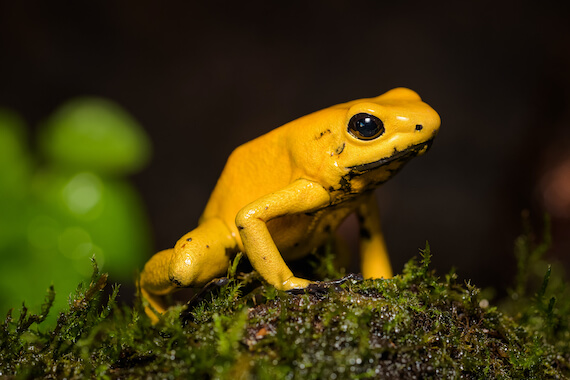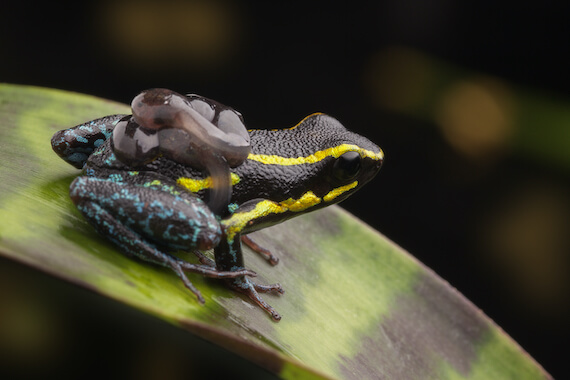
| Kingdom | Animalia |
| Phylum | Chordata |
| Class | Amphibia |
| Order | Anura |
| Superfamily | Dendrobatoidea |
| Family | Dendrobatidae |
| Genus | 16 genera |
| Species | Around 200 species |
| Niche | Carnivorous poisonous tropical frog |
| Length | 0.59 – 2.4 inches (1.5 – 6 cm) |
| Weight | 1 ounce (28.3 g) on average |
| Lifespan | 3 – 15 years |
| Social Structure | Pairs or small groups |
| Conservation Status | Species vary from least concern to endangered |
| Preferred Habitat | Tropical rainforests of Central and South America |
| Average Clutch Size | 1 – 40 eggs |
| Main Food Item | Small insects including ants and termites |
| Predators | Snakes, birds and crabs |
The Basics
The poison dart frog is a group of around 200 species of frog native to tropical regions of Central and South America. Poison dart frogs generally inhabit humid rainforests, but can also be found in shrublands, marches, swamps and seasonally flooded grasslands. Whilst most species tend to live on or close to the ground, some live in trees as high as 33 feet (10 meters) above ground. Many species of poison dart frog exhibit brightly colored, patterned bodies, which come in pretty much every color of the rainbow and vary greatly both between and within species.
Poison dart frogs are toxic due to the secretion of alkaloid toxins through glands in their skin. However, these frogs do not synthesize their poison themselves. Instead, it is thought that these animals derive their toxicity from their diet, which includes ants, termites, mites, centipedes and beetles. It seems that poison dart frogs are able to sequester chemicals from their prey, which then collect in their skin glands. This hypothesis is supported by the fact that poison dart frogs raised in captivity on a different diet are not toxic.
The largest and most dangerous species of poison dart frog is the golden poison frog, which is native to the Pacific coast of Columbia. A single individual of this species harbors enough poison to kill 10 grown men. The name poison dart frog derives from the fact that indigenous tribes use the poison of the golden poison frog and other species to coat the tips of their blow darts. Although the toxins of poison dart frogs are dangerous for most predators, certain species have evolved resistance to these toxins. One such example is Erythrolamprus epinephalus, a snake that can prey on the golden poison frog and live to tell the tale.

Reproduction
Poison dart frogs are social animals and often associate in pairs or small groups. Both males and females are territorial and engage in wrestling matches to settle disputes. Males fight for the best spots from which to broadcast their mating calls, whilst females fight for the best nesting sites and will even invade the nests of other females to eat their eggs. Poison dart frog courtship behavior often lasts for a number of hours, during which time a pair will visit multiple potential nesting sites before they choose one and begin mating.
Female poison dart frogs lay small clutches of 1 – 40 eggs, which are usually deposited in a dark, moist, quiet environment such as under leaf litter, in the crook of a branch or in the base of a bromeliad leaf. Similar to most fish, poison dart frogs practice external fertlization, whereby a male fertilizes a female’s eggs after they have been laid. Unlike other amphibians, poison dart frogs put significant amounts of energy into caring for their young, with both parents tending to the eggs to keep them moist and protect them from fungal growth or predators.
Once poison dart frog eggs have hatched, the tadpoles of many species wriggle onto their parents’ backs in order to be carried to a water source. Here they usually feed on invertebrates, in addition to unfertilized eggs laid by their mother to supplement their diet. In the case of the blue poison frog, tadpoles will even eat their siblings, so their parents must find a separate water source for each hatchling. Over the course of several months, tadpoles develop limbs and lungs and eventually metamorphose into adult frogs.

Fun Facts about Poison Dart Frogs
From their bright colors to their toxic skin and its uses, poison dart frogs exhibit a number of traits that provide examples of interesting biological concepts.
Aposematic Signalling
Poison dart frogs often have brightly colored bodies to warn predators of their toxicity, which is an example of aposematic signalling. Aposematism is common amongst animals that are difficult to kill or eat due to their toxicity, foul taste, sharp spines or aggressive nature, for example. In addition to bright coloration, aposematic signals might also include conspicuous sounds, such as those of rattlesnakes, or strong odors, such as those emitted by a number of insect species upon attack. Aposematic signals are beneficial not only for the species with these traits but also for their predators because they prevent both parties from being harmed.
The brightness of individual species of poison dart frog is correlated with toxicity. Thus, the most dangerous species are very brightly colored, whereas species with little to no toxicity are cryptic in order to blend in with their environment and hide from predators. Unlike most other frogs, poison dart frogs are diurnal. This means that they are active during the day and is probably an adaptation to allow their colorful skin to be seen by predators, as a brightly colored warning signal is unlikely to be a useful at night when predators cannot see it.
Polymorphism
Multiple species of poison dart frog exhibit a number of different color morphs, therefore taxonomic classification within this family has traditionally been difficult to elucidate and some current classifications remain controversial. Given that the color morphs of certain species diverged from each other as recently as 6,000 years ago, different morphs are still able to interbreed in these species. For the granular poison frog, variation in predation pressures across its range is thought to have driven the evolution of different color morphs. However, for the strawberry poison frog, sexual selection and variation in female preference for male skin color seems to have driven differentiation between morphs.

Repurposing Toxins
Each species of poison dart frog produces a different toxin with a different mix of alkaloids, which scientists have been studying to understand their potential use in medicine. Molecules derived from the toxins and venoms of a wide variety of animals including lizards, snakes and snails have been used in drugs for over 30 years to treat conditions such as type two diabetes, chronic pain and hypertension. These molecules are the products of hundreds of millions of years of evolution and are much larger than synthetic small molecule drugs such as aspirin. As a result, drugs derived from animal toxins have very specific targets within the body and generally produce fewer side effects than synthetic drugs.
It might seem counterintuitive that poisons can be used to treat illness, but by isolating certain molecules, scientists are able to take advantage of their specific properties. For example, the toxin of the phantasmal poison frog has been developed into a painkiller that is 200 times more effective than morphine. A complex chemical process is required to produce the drug, however, during which the potency of the toxin must be reduced to make it safe for use in humans. Poison dart frog toxins could also be used in other medicines in the near future and show promise for the development of heart stimulants and muscle relaxants.
